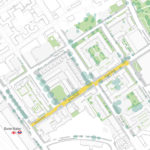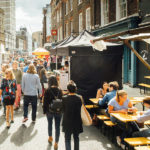Now is possibly the most exciting time to be in transport planning since the 1960s. In the same way that during that period road space was rapidly being created for the car, the current health crisis is giving towns and cities across the country the opportunity to allocate much needed space to pedestrians and cyclists.
It is now that local authorities are going through their wish lists of schemes that were not possible or had been shelved due to highway network capacity or concerns from residents and businesses about the knock-on effects.
It is an opportunity to test schemes, addressing gaps in the cycle network and dealing with areas where large numbers of pedestrians and cyclists did not have adequate space prior to Covid-19. This work can be phased and monitored to address local concerns and allow people to experience how spaces can be used differently. This is our chance to design our public highways and public space for the future we would like to see – to create people-friendly streets and address climate change.
In London, the City of London will be implementing its first wave of road space reallocation across its network during June 2020. The City is looking to balance demand for public transport and businesses, whilst providing more space for walking and cycling and implementing schemes that have the potential to be permanent. Measures include timed closures to motor vehicles, or making streets one-way as well as providing more space for walking, queuing, cycling and buses on streets such as Cannon Street, Cheapside and Leadenhall Street. The measures will also feed into their developing Climate Action Plan.
Elsewhere in London, Camden Council has asked the public to nominate locations in the borough for more space for walking and cycling. Camden is also widening footways on Kilburn High Road and closing some residential roads to through traffic.
Hammersmith and Fulham is using pop-up planters and allotments to create temporary road closures, changing people’s experience of public space.
TfL has already closed two bridges to general traffic, Waterloo Bridge and London Bridge, and is looking at similar measures between London Bridge and Shoreditch; Euston and Waterloo; and Old Street and Holborn. It is also implementing temporary footway space and cycle lanes and has brought forward the implementation of two permanent cycleways; Cycleway 9 between Kensington Olympia and Brentford and Cycleway 4 between Tower Hill and Greenwich. These measures could help to broaden the appeal of cycling to women and older people in particular; TfL’s “Travel in London: Understanding our diverse communities 2019”, states than women are less likely to cycle than men (13% of women cycle in London compared to 22% of men) and cycling in the over 65 age group is far lower than in the population of London as a whole (4% of people over 65 cycled in the last year compared to 17% of all Londoners).
All of these measures allow more space for people to walk and cycle as we see the lockdown easing. It’s a genuine opportunity to capitalise on the number of people who have taken up or re-discovered walking and cycling for leisure during the crisis. I hope that the pause in our day-to-day lives that we’ve all experienced can truly provide an impetus: to make changes now which lead to the adoption of permanent measures, and to convert this opportunity into long-lasting modal shift.







